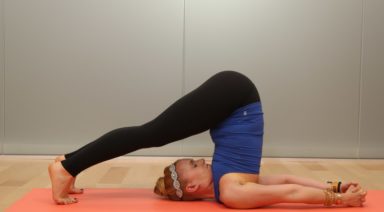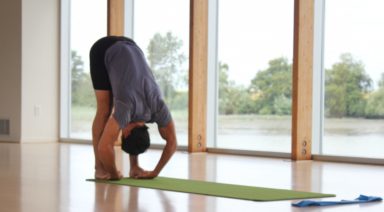Kapalbhati Pranayama

Step by Step and Shining Face.
Kapal in Sanskrit means FOREHEAD, and Bhati in Sanskrit means SHINING. Practicing Kapalbhati on regular basis leads to shining face with inner radiance. Kapalbhati is highly energizing abdominal breathing exercise.
What we do in Kapalbhati Pranayama
In Kapalabhati we do quick exhalation and natural inhalation. Normally exhalation takes one fourth of the time of inhalation. Quick exhalation and natural inhalation follow each other.
How to do Kapalbhati Pranayama
Step 1. Sit in comfortable crossed leg position with Back straight. Hands resting on knees in either chin or gyana mudra. Face to be relaxed.
Step 2. Inhale deeply through both nostril, expanding abdomen and exhale with the forceful contraction of abdominal muscles. (Pull the abdomen in by quickly contracting the abdominal muscles and exhale through the nose). The air is pushed out of lungs by contraction of the diaphragm.
Step 3. After exhalation again inhalation but inhalation should not involve any effort. To inhale just relax and the lungs will automatically expand and filled with air.
One can begin with 15 respiration. After completing 15 quick exhalation and natural inhalation , inhale and exhale deeply. This is one round.One can start the practice of Kapalbhati pranayama with 3 such rounds for practice.
Benefits of Kapalabhati
- Kapalabhati cleanses the lungs and entire respiratory system.
- The blood is purified and body gets an increased supply of oxygen to all cells.
- Digestion is improved.
- Abdominal muscles are strengthened.
- Prepare the mind for meditation.
- Energize the mind for mental work.
Precautions:
Kapalbhati should not be practice by those:
- Suffering from heart disease
- High blood pressure
- Hernia
- Should never be practiced when an asthmatic attack is in progress
- If pain or dizziness is experienced ,it is preferable to stop the practice till the sensation has passed. Practiced can be restarted with less force
- Quick exhalation should be comfortable to oneself. i.e. quick exhalation should not be too forceful
Common Mistakes:
- Abdomen is contracted while inhaling.
- Shoulders are contracted to push the air out when exhaling.
- Back and shoulders move during exercise.
****Points to Note:****
- Exercise should not be done if you are feeling uncomfortable at any time during the exercise.
- Rapid breathing used in this technique should be from the abdomen and not from the chest.
- Kapalbhati should be practiced on an empty stomach only.
- Kapalbhati should be practiced after the asanas and Relaxation (at least 10 minutes) and before meditation
- Chest should not move very much.
- It is always good and advisable that this exercise should be learned under supervision of yoga teacher after discussion with him about your health.
Pranayama Breath Control: The Key to Maximizing Your Energy

Yoga is an ancient practice that can take many different forms. From devotion, to physical movement, to the quest for knowledge, yoga is as unique as all of its various practitioners. Breath control has been and continues to be a large part of yoga. It is believed that breath control not only enhances clarity but, helps to restore the body’s natural flow of energy. In yoga there are more forms of breath control than you might imagine. The word pranayama can be broken down into two smaller words. The first word, “prana”, is the name for the life force or energy that flows through the body. The second half of pranayama is “ayama” which means extension or control. Alternately, the Sanskrit word “pra” also means before, or “to breathe”. This article will explore some of its forms, such as Samavrtti, Ujjayi, Kumbhaka, Anuloma Viloma, Kapalabhati, and Sithali. Although their names might sound complicated these breathing techniques are easy to practice and have varying degrees of mastery – much like yoga itself.
Samavrtti: The first type of breath control is the most normal and well known to every person that walks this Earth. Samavrtti in Sanskrit means “same action”. This is a steady even breath where the inhale matches or is equal to the exhale in duration. This is a slow and steady breath, the breath of relaxation. To begin practicing this form of breath control, inhale for four counts and then exhale for four counts. This action is believed to calm the mind and create a sense of balance.
Ujjayi: The next form of breath control is the most commonly practiced in yoga. Ujjayi breath means “victorious breath” in Sanskrit and is sometimes called the “ocean breath.” Ujjayi breath is an audible breath. This is formed by partially closing the epiglottal passage or slightly closing the throat. Much like Samavrtti, this breath is even. To practice Ujjayi close your mouth and breath in slowly and continuously for four counts. Exhale in the same manner, keeping the breath in through the nose. This form of breath control is said to help tone the internal organs, increase body health, improve concentration, and more.
Kumbhaka: This is the practice of holding one’s breath, which is where this form draws its name. Kumbhaka in Sanskrit means “to retain the breath”. Continuing to build on the pranayama previously described, begin with Ujjayi. Once you have established a comfortable rhythm, hold your breath for four to eight counts in between every four breaths. In the beginning your Kumbhaka or retention should start off shorter. As you become more practiced in this art, begin increasing the retention. Also one may begin to reduce the number of breaths in between the retentions. Kumbhaka is believed to strengthen the diaphragm, restore energy and cleanse the respiratory system.
Anuloma Viloma: This form of pranayama might look a bit funny to us Western practitioners of yoga but it is quite beneficial. Anuloma Viloma means Alternate Nostril Breathing in Sanskrit. Much like its name implies, practitioners use their right hand to alternate closing your different nostrils. The first step to learning how to practice this form of breath control is the Vishnu Mudra or hand position with the index and middle fingers curled. Lightly press your right thumb on the outside of the right nostril and inhale only through your left nostril. Keep your mouth closed. Close your left nostril with your ring finger and hold your breath momentarily. Release your thumb and exhale through the right nostril. Repeat the process inhaling through the right nostril. Start slowly with a low number of cycles and then progress from there. This form of breath control is believed to promote the flow of energy, as well as lower the heart rate and relieve stress.
Kapalabhati: Also known as “The Shining Skull,” this type of pranayama is a little bit different from those we have previously explored. Kapalabhati incorporates a rhythmic action by pumping your abdominal muscles on the exhales. Loosen up your abdominal muscles before beginning this practice. To begin, fill your lungs and then push all of the air out in a quick thrust. Inhalation automatically follows, creating this rhythm of breathing. Upon the exhale you have completed one cycle. When starting this practice begin with a low number of cycles or repetitions such as 10. Continue to build from there working up towards four rounds of twenty cycles of breath. This pranayama is thought to strengthen the diaphragm, restore energy and cleanse the respiratory system.
Sithali: Our final form of pranayama for this article, sithali, is roughly translated as “The cooling breath.” This form differs from other types of pranayama as the inhale is drawn through the mouth. Begin by curling your tongue and then slightly stick it out. Draw your breath in through your curled tongue, retain the breath closing your mouth and exhale through your nose. Repeat this process anywhere between five to ten cycles. This type of prana energy is believed to cool the body while providing a feeling of wellness.
**Contraindications: Some pranayama techniques such as breath retention or sharp, forceful breathing may not be safe during pregnancy.
**References: Much of this information comes from the wonderful resource of “Anatomy of Yoga” by Dr. Abigail Ellsworth

































